Ghost
From Dubrovnik we returned north toward Slovenia, stopping along the way to spend one night in the peaceful, almost backwater, Croatia fishing village of Trogir. Like Dubrovnik, Trogir was a walled city of roughly Venetian vintage, but Trogir’s wall has largely crumbled away or been removed, though I know not how or why. Still it had the gorgeous narrow cobblestone streets, arched doorways and high towering forts that give all these Dalmatian towns their Rapunzel-like fairly tale quality.
Trogir was notably different from Dubrovnik chiefly in that it was not inundated with tourists. There were tourists to be sure, but most of them were yachters who contented themselves by sitting in the waterfront cafes just in front of their moorings, admiring each other’s yachts and telling sea tales.
The rest of the town was given over to a handful of tourists who disappeared among the narrow winding streets such that I often found myself walking for long periods of time undisturbed by a soul. We wandered into the main church, a large stone block affair just off the central square and only recently restored, just before sundown. The church was small and unremarkable save for its old tombstones or at least headstones, embedded right in the floor next to the pews. I had recently finished reading an essay by W.G. Sebald in which he argues, among other things, that our use of tombstones and crypts is really spurred by an urge to lock the dead in the earth, which we cleverly disguise to ourselves as commemorative memorials.
a large stone block affair just off the central square and only recently restored, just before sundown. The church was small and unremarkable save for its old tombstones or at least headstones, embedded right in the floor next to the pews. I had recently finished reading an essay by W.G. Sebald in which he argues, among other things, that our use of tombstones and crypts is really spurred by an urge to lock the dead in the earth, which we cleverly disguise to ourselves as commemorative memorials.
I stood for a minute in the church watching the last sunbeams fall in through the windows near the roofline wondering if in fact just beneath me, buried in the fourteenth century, was some man or woman desperate to get out and wander the earth, slightly smaller than in life, as the dead are said to be, but larger in understanding and memory. 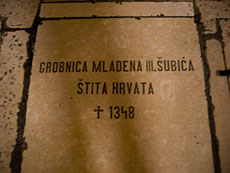 I think it was Nabakov who said in one of his novel that writers and the dead travel in the same thing—the past. Indeed I have found, not just through sloth, that I prefer to write these anecdotes as past tense and see what remains with me a few days after I have left.
I think it was Nabakov who said in one of his novel that writers and the dead travel in the same thing—the past. Indeed I have found, not just through sloth, that I prefer to write these anecdotes as past tense and see what remains with me a few days after I have left.
This is why perhaps I may seem to have missed some fairly key things, like for instance the oldest pharmacy in the world which I saw in Dubrovnik, because the truth is, I simply don’t have time to record everything. I remember the pharmacy now with its a collection of shelves full of dusty bottles and curios who use has long been forgotten, but when 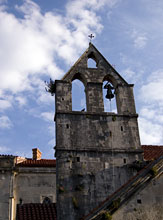 I came to write of Dubrovnik it was not there. Memories come and go, pass through us like the ghosts that live in them. Sometimes they are there when we want them, sometimes they are not, and sometimes they are there when we don’t want them as well.
I came to write of Dubrovnik it was not there. Memories come and go, pass through us like the ghosts that live in them. Sometimes they are there when we want them, sometimes they are not, and sometimes they are there when we don’t want them as well.
So if I say in Trogir that I remember little more than the peculiar quality of the light as the sun set and electric lanterns began to come on, you will forgive me I hope for my inability to say more. Certain memories passed through me walking the streets of Trogir in the fading twilight, that are too old to speak of here, too far gone to retrace, it is enough for them to merely pass through, a bit of warmth and then they move on. I can say of Trogir though, 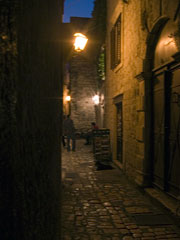 if you don’t believe in ghosts, have a late night walk in the old city and tell me how you feel about ghosts when you’re done. I have never doubted that the dead move among us, and never been so sure of it as standing in that church staring down at the tombstones from the thirteenth century.
if you don’t believe in ghosts, have a late night walk in the old city and tell me how you feel about ghosts when you’re done. I have never doubted that the dead move among us, and never been so sure of it as standing in that church staring down at the tombstones from the thirteenth century.
The following morning after watching the fisherman board their craft and motor out to sea, we climbed back in the car and drove on north to Ljubljana, Slovenia. Some of you may know that I have for some years (though not recently) published a literary journal under the name castagraf (which is currently being held ransom by some asshole domain squatters, so no link at the moment). To come to the point, in the course of several issues castagraf 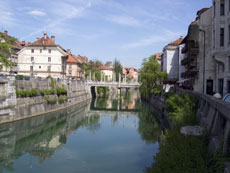 I published a number of Slovenian authors, most notably the highly esteemed Tomaz Salamun, Slovenia’s national poet, or whatever title they have for the same idea. But along with Tomaz we published to two younger poets whom I would have liked to meet in Ljubljana, but I did not, owing in part to my own incompetence and in part to the estranged relationship I have with my former co-editor who processes their email address.
I published a number of Slovenian authors, most notably the highly esteemed Tomaz Salamun, Slovenia’s national poet, or whatever title they have for the same idea. But along with Tomaz we published to two younger poets whom I would have liked to meet in Ljubljana, but I did not, owing in part to my own incompetence and in part to the estranged relationship I have with my former co-editor who processes their email address.
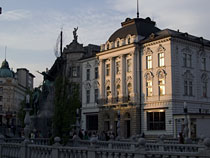 So I was unable to look you up Primoz and Gregor for which I am sorry. I should liked to have met you both. But I did enjoy Ljubljana for the two says I spent there, a truly lovely city to call home. Ljubljana is one part old European city and one part college town owing to its relatively small size and large university. The center of town is two streets running parallel on opposite sides of the river, each street lined with cafes and restaurants frequented by locals and tourists alike.
So I was unable to look you up Primoz and Gregor for which I am sorry. I should liked to have met you both. But I did enjoy Ljubljana for the two says I spent there, a truly lovely city to call home. Ljubljana is one part old European city and one part college town owing to its relatively small size and large university. The center of town is two streets running parallel on opposite sides of the river, each street lined with cafes and restaurants frequented by locals and tourists alike.
Though we spent a very short time in Ljubljana it remains one if my favorite European cities and it was fun to wander the streets where so many of my friends have previously been and which I had heard no shortage of stories about. It was nice as well to see the hometown of Tomaz Salamun whose poetry has had no small influence on my own.
I spent the evening walking the streets trying to get a feel for the city. As the sun set and it began to grow cooler I stopped to put on a sweater and noticed a singularly striking and a little bit frightening piece of graffiti. What struck me about it was the contrast between 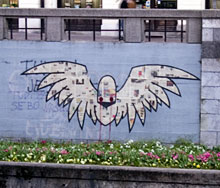 the gleaming, blood dripping eyes of the bat-like creature above a bed of blooming flowers which seemed for a moment to perfectly encapsulate the contrast between pain and joy that makes up our world. Later that night I dreamed about the strange bat creature, something about it got the better of my imagination, already overrun as it was with ghosts and memories of the dead, but at the end of the dream, of which I recall very little, the flowers were just coming up out of the soil, and the bat was no longer anywhere to be found.
the gleaming, blood dripping eyes of the bat-like creature above a bed of blooming flowers which seemed for a moment to perfectly encapsulate the contrast between pain and joy that makes up our world. Later that night I dreamed about the strange bat creature, something about it got the better of my imagination, already overrun as it was with ghosts and memories of the dead, but at the end of the dream, of which I recall very little, the flowers were just coming up out of the soil, and the bat was no longer anywhere to be found.
Thoughts?
Please leave a reply:
All comments are moderated, so you won’t see it right away. And please remember Kurt Vonnegut's rule: “god damn it, you’ve got to be kind.” You can use Markdown or HTML to format your comments. The allowed tags are
<b>, <i>, <em>, <strong>, <a>. To create a new paragraph hit return twice.